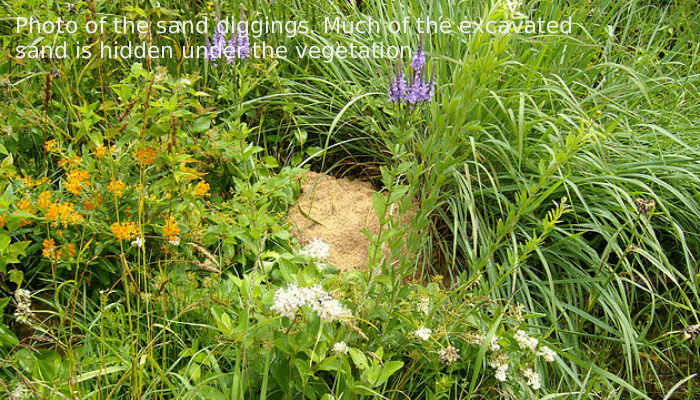A Biodiversity Detective – Unraveling the Clues

Here’s a great example of an experience trying to document whether an endangered species or species at risk has been found on a property that is being restored – very similar to Bur Oak Land Trust’s efforts to document the rusty patched bumblebee at Turkey Creek Nature Preserve:
The reaching goal of restoration practitioners is to enhance and preserve the biodiversity of the sites we manage. Typically, our managed sites are small, fragmented and isolated remnants of an endangered ecosystem, with many members of the flora and fauna communities missing. By restoring absent ecological processes such as fire, and removing invasive species, some lost ecosystem members may return on their own. Practitioners may be able to add lost members, such as plant species, if nearby seed sources are available. But many of the rare fauna species may never return. Finding “new” rare ecosystem members in the sites we manage is the “holy grail” of ecological restoration. However, it’s not always easy to prove they exist due to their secretive nature and/or lack of scientific information.
Over the summer, standing on the toe slope of a steep sand prairie hillside, I stopped to take in the incredible beauty. Below me was a forb-rich tallgrass prairie that graded into wet prairie dominated by prairie cordgrass. Above me, the little bluestem and Indian grass dominant hillside graded into a bur oak dominant savanna. Scattered about at the intersection of the hill prairie and oak savanna, were sandstone rock outcroppings, sun-bleached in shades of white, yellow and tan.
A mound of fresh, sandy diggings caught my eye, and I moved over to the steep bank to investigate. There were small tracks in the sand. But the earlier rain had dulled them too much for identification. There was a lot of sand, enough to fill three five-gallon buckets, much of it hidden under the tall vegetation. I found the opening of the hole, and froze. This can’t be? The hole’s diameter was about 3 inches, too small for a badger or ground hog. We have moles and thirteen-lined ground squirrels in the area, but neither species digs in this manner, I thought. Maybe it’s a baby ground hog? But I hadn’t seen young ground hogs exhibit this behavior before. Then it hit me. Maybe it was none of these. Maybe it was something new? Could it be a Franklin’s ground squirrel?
Very unlikely, I thought.
The following evening I forego “couch” time and visit the Internet looking for clues to the mystery. According to the Wisconsin DNR, Franklin’s ground squirrel is an at-risk species (Special Concern) and there have been historical sightings in the county where the site is located. I dig deeper, looking for scientific references that describe what kind of burrows they dig. The few references I find briefly mention hole diameters of 3 inches to 3.2 inches, dug into banks with the dirt spoils deposited below the hole. This fits. However, they also mention multiple entrances, and I only found one.
Weeks later, walking on the same property along a fire break separating a grassy area with scattered oak saplings from a large tallgrass prairie planting dominated by big bluestem and Indian grass, I spot what appears to be a small gray squirrel dart across the fire break and into the tall prairie grasses. It piqued my interest but disappeared into the prairie before I could identify it. A short time later, about 100 yards along the same fire break, another small gray squirrel-like critter popped out of the grassy oak sapling area and stopped for a brief moment, then melted away into the tall prairie grasses. He looked similar to a small gray squirrel but with a shorter tail and brown coloration on his rump.
I thought, could this be a Franklin’s ground squirrel? It matched the description of one based on my earlier research. Naw, I thought, my eyes are likely just playing tricks on me. Even though there are no mature trees close by, and I’m in the middle of a grassland, it’s probably just migrating young gray squirrels looking for new territory.
A week later, back on the same property not far from the sandy burrow I discovered earlier, I heard an unfamiliar twill. That’s not a bird, I thought, and its pitch is deeper, richer than and not as piercing as the twill of a thirteen-lined ground squirrel. More evidence of a Franklin’s ground squirrel?
That evening, I’m on YouTube listening to recorded Franklin’s ground squirrel calls. Yep, that’s definitely what I heard, I think. Or is it what I want to believe, and what I really heard was a “throaty” thirteen-lined ground squirrel twilling in tenor?
Even with all of this circumstantial evidence, I wonder if I’m not chasing a ghost? It’s easy to believe what one wants to believe. Next year, I need to spring for a few trail cameras. If I can capture one in a photo, I’ll be able to prove to myself it’s real.
Originally published on Environmental Returns
Tags: biodiversity, David Cordray, habitat restoration, species restoration

